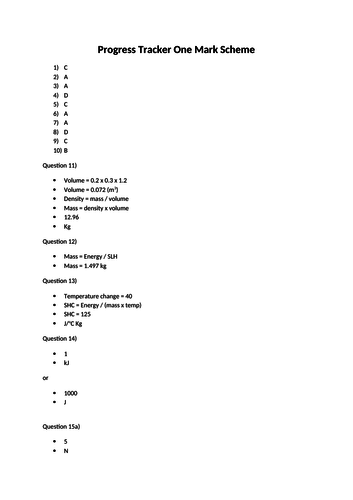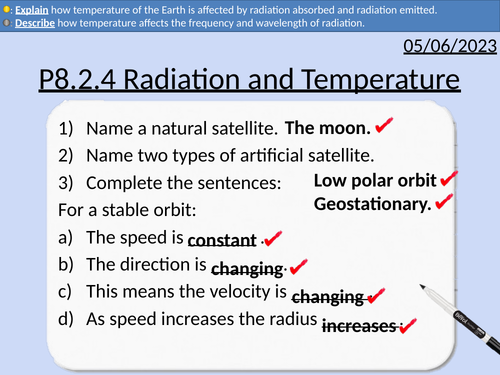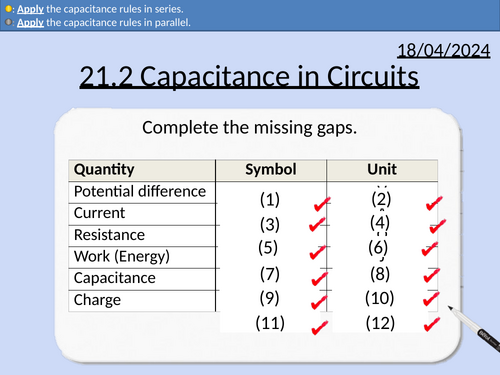484Uploads
146k+Views
64k+Downloads
All resources

OCR AS Physics: Analysing Circuits
OCR AS Physics: Analysing Circuits is a part of the Module 4: Electrons, Waves, and Photons. PowerPoint with worked examples and homework.
Drawing and labeling circuit diagrams
Adding Resistors in Series and Parallel
Ohm’s Law
Kirchhoff’s Laws
The Electrical Power Equation

GCSE OCR Physics: Circuit Calculations
This presentation covers OCR Gateway Physics 9-1 P3.2.6 Circuit Calculations.
Measuring current and potential difference
Adding resistors in series and parallel
Rearranging Ohm’s Law
Rules for series circuits
Worked solutions to series circuit exam questions
Rules for parallel circuits
Worked solutions to parallel circuit exam questions

GCSE Physics: Pressure and Surface Area
This presentation covers OCR Gateway Physics 9-1 P1.3.2 Pressure and Volume
This presentation includes:
Calculating surface area
Pressure equation with worked example
Rearranging pressure equation
Pressure equation problems with full solutions

GCSE OCR Physics P1 Test
35 mark assessment with mark scheme for P1 from OCR Gateway Physics 9-1.
Includes:
10 multiple choice questions
Density
Specific Latent Heat
Specific Heat Capacity
Pressure
Development of the atomic model
Unit conversion
Included physics equations
PIN cover sheet

OCR A level Physics: Kinetic Theory of Gases
OCR A level Physics: Kinetic Theory of Gases is a part of the Module 5: Newtonian World and Astrophysics. The PowerPoint presentation includes worked examples, solutions and a homework.

OCR A level Physics: Root mean square speed
OCR A level Physics: Root mean square speed is a part of the Module 5: Newtonian World and Astrophysics. The PowerPoint presentation includes worked examples, solutions and a homework.

OCR A Level Physics: Analysing Simple Harmonic Motion
OCR A Level Physics: Analysing Simple Harmonic Motion presentation with homework and answers.

GCSE Physics: Kinetic energy and Work done
This presentation covers OCR Gateway Physics 9-1 P7.1.1b Kinetic energy and Work done.
PowerPoint includes student activities with fully worked answers included.
Work done and kinetic energy equations
Rearranging equations
Mechanical energy transfer and work done
Kinetic store transfered mechanically to a thermal store through brakes.

GCSE Physics: Gravitational and Elastic Energy
This presentation covers OCR Gateway Physics 9-1 P7.1.7 Gravitational and Elastic Energy
Energy transfers with links to sport and PE.
Employer-mentor links with physics and sports
Exam Style Question with worked solutions
Rearranging equations
Practice Questions with worked solutions

GCSE Physics: Forces in Collisions
This presentation covers OCR Gateway Physics 9-1 P8.1.4 Forces in Collisions. All presentations come with student activities and worked solutions.
Large accelerations produce large forces.
Values of g that cause severe injury or death
Road Safety
Newton’s First Law and seat belts
Crumple zones
Force = Mass x Acceleration
Acceleration = Change in velocity /Time taken
Estimating speed, accelerations and forces involved in large accelerations for everyday road transport.

GCSE Physics: Radiation and the body
This presentation covers OCR Gateway Physics 9-1 P6.2.1 Radiation and the body
This PowerPoint is a whole lessons included with student activities and animated answers.
Background radiation definition
Sources of background radiation
Contamination and irradiation
Medical examples of irradiation - X-rays, sterilisation, gamma knife
Medical examples of contamination - Tracers
Half-life and penetration power for radioactive tracers.

GCSE Physics: Radiation and Temperature
This presentation covers OCR Gateway Physics 9-1 P8.3.4 Radiation and Temperature
This PowerPoint is a whole lessons included with student activities and animated answers.
All objects emit electromagnetic radiation
Describe how changing temperature changes frequency, wavelength, and intensity of the radiation produced.
Explain why objects change temperature by absorbing and emitting radiation.
Explain why the temperature of the Earth changes due to greenhouse gases in the atmosphere.
Bundle

OCR A level Chemistry: Carbonyl and Carboxylic Acids
OCR A level Chemistry: Aromatic Compounds is apart of the Module 6: Organic Chemistry and Analysis.
All presentations come with worked examples, solutions and homeworks
26.1 Carbonyl Compounds
26.2 Identifying Aldehydes and Ketones
26.3 Carboxylic Acids
26.4 Carboxylic Acid Derivatives
The carbonyl group
Differentiating between aldehydes and ketones
Naming aldehydes and ketones
Oxidation of aldehydes
Electronegativity and polar bonds
Electrophiles, nucleophiles, and nucleophilic addition reactions
Reducing carbonyl compounds with sodium tetrahydridoborate(III) (NaH4)
Primary and secondary alcohols from carbonyl compounds
Reacting carbonyl compounds with hydrogen cyanide (HCN)
Reaction mechanisms for nucleophilic addition using (NaBH4)
Reaction mechanisms for nucleophilic addition using (HCN)
Testing for Carbonyl Groups
Brady’s reagent - 2,4-dinitrophenylhydrazine - 2,4-DNP
Distinguishing between Aldehydes and Ketones
Tollen’s reagent - silver nitrate in aqueous ammonia
The Carboxyl Group and polarity of bonds.
Naming carboxylic acids
Carboxylic acids as weak acids
Reactions of carboxylic acids with:
Metals
Metal oxides
Alkali
Carbonates
Changing solubility of carboxylic acids in water due to carbon chain length.
Naming acyl chlorides
Naming acid anhydrides
Naming esters
Esterification
Acid hydrolysis of esters
Alkali hydrolysis of esters
Producing acyl chlorides from carboxylic acids
Producing carboxylic acids from acyl chlorides
Producing esters from acyl chlorides and phenols
Primary, secondary, and tertiary molecules
Producing primary amides from acyl chlorides
Producing secondary amides with acyl chlorides
Producing esters and carboxylic acids wirh acid anhydride

GCSE OCR Physics 9-1 Paper 1 Revision Booklets
OCR GCSE Physics Paper 1 for higher tier (triple and combined) are covered with individual revision booklets.
Each booklet has:
Link to specification number
Denotes if it is higher or combined material
Equations to recall and apply for that section
Equations to apply for that section
Key Points
Exam questions
Mark Schemes for each question
Triple Booklets:
P1.1 The Particle Model
P1.2 Changes of State
P1.3 Pressure
P2.1 Motion
P2.2 Newton’s Laws
P2.3 Forces in action - Simple Machines
P2.3 Forces in action - Springs and Gravitational Energy
P3.1/2 Electricity
P4.1 Magnetism
P4.2 Uses of Magnetism
Combined Booklets:
P1.1 The Particle Model
P1.2 Changes of State
P2.1 Motion
P2.2 Newton’s Laws
P2.3 Forces in action - Springs and Gravitational Energy
P3.1/2 Electricity
P3.3 Magnetism and Fields

GCSE OCR Physics 9-1 Paper 2 Revision Booklets
OCR GCSE Physics Paper 2 for higher tier (triple and combined) are covered with individual revision booklets.
Each booklet has:
Link to specification number
Denotes if it is higher or combined material
Equations to recall and apply for that section
Equations to apply for that section
Key Points
Exam questions
Mark Schemes for each question
Triple Booklets:
P5.1 Wave Beahviour and Wave Velocity
P5.2 Electromagnetic Waves
P5.3 Wave Interactions
P6.1 Radioactive Emissions
P6.2 Uses and Hazards - Fusion and Fission
P7 Energy
P8.1 Physics on the move
P8.2 Powering Earth
P8.3 Beyond Earth
Combined Booklets:
P4.1 Wave Beahviour and Wave Velocity
P4.2 Electromagnetic Waves
P4.3 Radioactice Emissions
P6 Energy
P6.2 Physics on the move
P6.3 Powering Eaerth

GCSE Physics: Electrical Current Practical Activity
This presentation covers OCR Gateway Physics 9-1 P3.1.2 Electrical Current
Electron flow and conventional current
Measuring current with ammeters
Series and parallel circuits
Comparing current at junctions

OCR A level Physics: Capacitors in Circuits
OCR A level Physics: 21.2 Capacitors in Circuits
Module 6 Particles and Medical Physics
This PowerPoint is a whole lesson included with student activities, animated answers, homework questions with answers provided.
This lesson covers:
Uses of capacitors in circuits.
Rules for capacitors in parallel (potential difference, charge, and capacitance).
Rules for capacitors in series (potential difference, charge, and capacitance).
Applying the rules in series and parallel.
Creating a circuit to calculate the charge stored on the capacitor.

OCR A level Physics: Alpha-particle Scattering Experiment
OCR A level Physics: 24.1 Alpha-particle Scattering Experiment
Module 6 Particles and Medical Physics
This PowerPoint is a whole lesson included with student activities, animated answers, homework questions with answers provided.
This lesson covers:
Developments of scientific models
Thompson’s plum-pudding model
Rutherford’s nuclear (planetary) model
Rutherford’s experiment, observations, and conclusions
Using Coulomb’s law to find the minimum distance between particles

OCR A level Physics: Radioactivity
OCR A level Physics: 25.1 Radioactivity
Module 6 Particles and Medical Physics
This PowerPoint is a whole lesson included with student activities, animated answers, homework questions with answers provided.
This lesson covers:
Types of ionising radiation (alpha, beta-plus/beta-minus, gamma)
Penetration power and ionising power
Detecting radiation with a Geiger (GM tube) counter
Background radiation and correct count rates
Electric and magnetic fields affect ionising radiation
Cloud chambers

Physics Display - Science Jobs/Women in Physics
Several word documents with content concerning women in physics and jobs in physics. These displays are in line with IoP recommendations to promote women in physics.




















